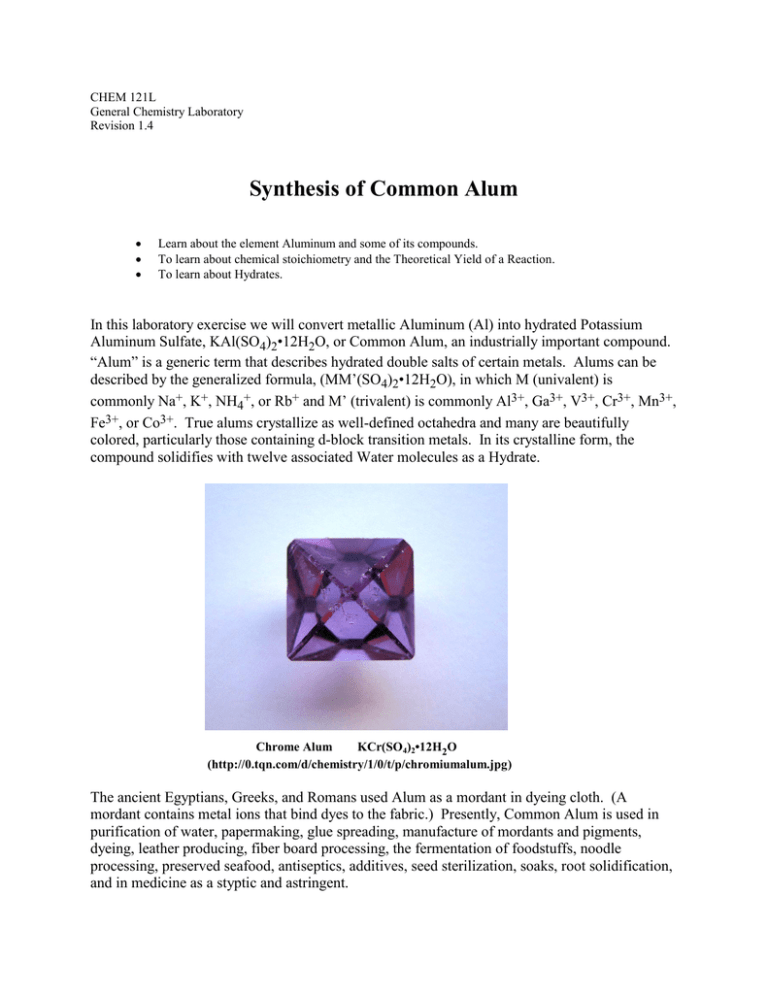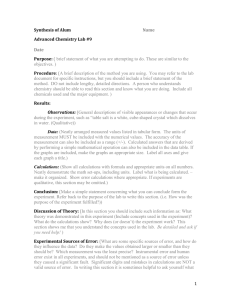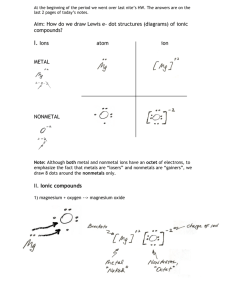Synthesis of Common Alum
advertisement

CHEM 121L General Chemistry Laboratory Revision 1.4 Synthesis of Common Alum Learn about the element Aluminum and some of its compounds. To learn about chemical stoichiometry and the Theoretical Yield of a Reaction. To learn about Hydrates. In this laboratory exercise we will convert metallic Aluminum (Al) into hydrated Potassium Aluminum Sulfate, KAl(SO4)2•12H2O, or Common Alum, an industrially important compound. “Alum” is a generic term that describes hydrated double salts of certain metals. Alums can be described by the generalized formula, (MM’(SO4)2•12H2O), in which M (univalent) is commonly Na+, K+, NH4+, or Rb+ and M’ (trivalent) is commonly Al3+, Ga3+, V3+, Cr3+, Mn3+, Fe3+, or Co3+. True alums crystallize as well-defined octahedra and many are beautifully colored, particularly those containing d-block transition metals. In its crystalline form, the compound solidifies with twelve associated Water molecules as a Hydrate. Chrome Alum KCr(SO4)2•12H2O (http://0.tqn.com/d/chemistry/1/0/t/p/chromiumalum.jpg) The ancient Egyptians, Greeks, and Romans used Alum as a mordant in dyeing cloth. (A mordant contains metal ions that bind dyes to the fabric.) Presently, Common Alum is used in purification of water, papermaking, glue spreading, manufacture of mordants and pigments, dyeing, leather producing, fiber board processing, the fermentation of foodstuffs, noodle processing, preserved seafood, antiseptics, additives, seed sterilization, soaks, root solidification, and in medicine as a styptic and astringent. Page |2 Aluminum is the third most abundant metal in the earth's crust. It occurs primarily in aluminosilicate minerals found in the original rocks of this outer portion of the Earth. Weathering of these rocks has formed aluminum-containing clays, which are an essential part of most soils. Further weathering of these clays has given rise to deposits of Bauxite, an aluminum containing ore made-up of AlO(OH) and Al(OH)3 in various proportions. Industrially, Bauxite is converted to the purified Oxide, Al2O3, via the Bayer Process. In this process, the Bauxite Ore is mixed with hot, aqueous Sodium Hydroxide solution, dissolving the Aluminum as the Aluminate Ion, Al(OH)4-: AlO(OH)(s) + OH-(aq) + H2O Al(OH)4-(aq) (Eq. 1) and: Al(OH)3(s) + OH-(aq) Al(OH)4-(aq) (Eq. 2) Silicate and iron oxide impurities remain undissolved and are filtered off. As the hot solution of Aluminate cools, Aluminum Hydroxide precipitates: Al(OH)4-(aq) Al(OH)3(aq) + OH-(aq) (Eq. 3) The precipitate is filtered off and heated to convert it to a white powder of anhydrous Aluminum Oxide: 2 Al(OH)3(s) Al2O3(s) + 3 H2O(g) (Eq. 4) Once the Oxide is obtained, it is mixed with Cryolite, Na3AlF6, heated to a molten state, and electrolyzed to form the free metal: 2 Al2O3(l) 4 Al(l) + 3 O2(g) (Eq. 5) This Hall Process for the production of Aluminum requires massive amounts of electricity. This explains why plants for the production of Aluminum grew up near sources of cheap electricity, such as the Bonneville Dam in Oregon. Today, the Aluminum used in industry is primarily obtained via the recycling of previously produced Aluminum. The process of synthesizing Common Alum starts with dissolving metallic Aluminum in aqueous solutions of strong bases like Potassium Hydroxide, KOH, to form hydrogen gas and a soluble salt containing the Aluminate Ion, Al(OH)4-: 2 Al(s) + 2 KOH(aq) + 6 H2O 2 KAl(OH)4(aq) + 3 H2(g) (Eq. 6) After the Aluminum has dissolved, the excess Potassium Hydroxide is neutralized by the addition of Sulfuric Acid, H2SO4. Sulfuric Acid also converts the complex ion, Al(OH)4-, to insoluble Aluminum Hydroxide, Al(OH)3: Page |3 2 KAl(OH)4(aq) + H2SO4(aq) 2 Al(OH)3(s) + K2SO4(aq) + 2 H2O (Eq. 7) The insoluble Aluminum Hydroxide is neutralized by excess Sulfuric Acid to form Aluminum Sulfate, Al2(SO4)3, a water soluble ionic compound: 2 Al(OH)3(s) + 3 H2SO4(aq) Al2(SO4)3(aq) Al2(SO4)3(aq) + 6 H2O 2 Al3+(aq) + 3 SO42-(aq) (Eq. 8) (Eq. 9) As the solution is cooled, the double salt, Hydrated Potassium Aluminum Sulfate, crystallizes out of the solution: K+(aq) + Al3+(aq) + 2 SO42-(aq) KAl(SO4)2•12H2O(s) (Eq. 10) The final product is collected by filtration. So, starting with an Aluminum pie plate, we will synthesize a useful Aluminum salt. Along the way we will observe two different complexes between Aluminum and Hydroxide Ion as well as the Sulfate salt of Aluminum. Page |4 Pre-Lab Safety Questions 1. How should an Aqueous Sodium Hydroxide spill be remediated? 2. Suppose you have a significant spill of concentrated aqueous Sodium Hydroxide solution on your clothing and skin. What should be your immediate response? 3. Alternatively, suppose the spill were one of Sulfuric Acid. What should be your immediate response? Page |5 Procedure Note: If the Addendum exercise is being performed, do step #1 of the addendum procedure before starting the synthesis of Alum. Aluminum Hydroxide vs. Aluminate Ion During the second step in the synthesis of Alum (Eq. 7), we convert the Aluminate Ion (Al(OH)4-) into Aluminum Hydroxide (Al(OH)3). The difference between these species can be observed directly by starting with aqueous Aluminum Ion, Al3+, and directly adding Hydroxide Ion, OH-. 1. Add approximately 3mL of 0.1M Al(NO3)3, our source of Al3+, to a large test tube. 2. To this, add dropwise 6M NaOH, our source of OH-, until you observe two distinct physical changes. The first of these changes is due to the formation of Aluminum Hydroxide: Al3+(aq) + 3 OH-(aq) Al(OH)3(s) The second is the conversion of Aluminum Hydroxide into Aluminate Ion: Al(OH)3(s) + OH-(aq) Al(OH)4-(aq) Synthesis of Common Alum 1. Obtain a piece of aluminum (approx. 0.5-0.9g). Weigh this accurately. Note: Many beverage cans are not alumninum, but are alloys that dissolve slowly. If you are using a scrap aluminum can as your source of aluminum, sandpaper it to remove as much lacquer as possible. Use a 1 inch x 2 inch piece. Cut the piece of aluminum into smaller squares of approximately one half inch on a side. Avoid using unusually thick pieces, such as the lip of a pie pan or the pop-top on a beverage can. 2. Place the aluminum in a 250 mL beaker and add 15mL of 6M KOH and 20mL of Water. Perform this operation in the fume hood and keep this away from flames. Heat very gently on a hotplate if it appears the reaction is proceeding too slowly. 3. Allow the solution to cool to room temperature, when the reaction is complete; i.e., stops producing hydrogen gas. Page |6 4. If the solution contains any remaining solid, filter it through a gravity funnel plugged in the bottom with a small piece of glass wool. Use a small amount of water (no more than 20mL) to rinse the beaker and funnel. 5. Add 10 drops of Methyl Red indicator to the solution. This Acid-Base indicator is yellow in basic solutions and red in acidic solutions. 6. Obtain 25mL 6M H2SO4 in a beaker. With vigorous stirring, add the acid, a few milliliters at a time, to the solution until it just turns red. (Avoid adding excess acid.) The addition of the acid will cause the precipitation of Al(OH)3. This will dissolve in the final acidic solution. 7. Gently heat the solution, with vigorous stirring, to cause all the Al(OH)3 to dissolve. If needed, add a few additional drops of acid, until the solution is red. 8. Allow the solution to cool. Allow the solution to stand, and form crystals, until the next laboratory period. Steps 9 & 10 Performed During Next Laboratory 9. Filter the crystals through a Buchner funnel. Wash the crystals with a small amount (no more than 20 mL) of Ethanol. 10. Allow the crystals to stand until dry. Weigh the resulting product. 11. Obtain a 3 dram vial and submit a sample of your product. Label the vial with the following information: Name(s) Name of Compound Formula of Compound Date Weight of Product Page |7 Data Analysis & Conclusions 1. Calculate the Theoretical Yield of Common Alum 2. Calculate the Percentage Yield of Common Alum. 3. Comment on your Sources of Loss. Page |8 Post Lab Questions 1. Based on the above formula for Aluminum Oxide (see Eq. 4), predict the chemical formulas for the oxides of the other Group 3A elements. Confirm, or disprove, your predictions by looking-up the chemical formulas in a handbook or by consulting an appropriate Internet site. 2. When powdered Aluminum is mixed with Ferric Oxide, Fe2O3, and ignited, a reaction occurs with the evolution of a great deal of heat, sufficient to melt the elemental Iron produced. Aluminum Oxide is the second reaction product. This process, called the Thermite process, can be used as a "portable" welding source. Write a chemical reaction for the Thermite process. 3. What is the Oxidation State of Aluminum in Aluminum Oxide? What is it in Common Alum? 4. Suppose I expect a loss of 40% when producing Common Alum via this method. How much Aluminum must I start with to produce 5g of Common Alum? Page |9 Addendum Properties of Hydrates It should be noted our product crystallizes as a Hydrate. Hydrates are salts that crystallize from a water solution and contain weakly bound water molecules. For example, Ferric Chloride, FeCl3, crystallizes with six water molecules weakly bound to the Fe3+ ion in an octahedral arrangement: This is denoted as FeCl3•6H2O and is referred to as Ferric Chloride Hexahydrate. Note the unusual method for writing the chemical formula of this compound. A hydrate is an addition compound; a compound that contains two or more simpler compounds. In the above example, the simpler compounds are FeCl3 and H2O, which combine in a ratio of six waters to every formula unit of Ferric Chloride. This is a weak chemical combination between the water and the salt. As such, the combination is denoted with a "dot." However, the water molecules are as much a part of the compound as the other atoms. As another example, Cupric Sulfate Pentahydrate, CuSO4•5H2O, has four water molecules loosely associated with the Cu2+ ion and one which bridges the SO42- ions on adjacent formula units of CuSO4. The bonding of the water to the Cu2+ is depicted in the figure (left) below. The bridging water molecule is depicted in the figure (right) below. [Note: You may want to have a pint of Beer, a glass of Wine (okay, maybe two), or some other libation before wading through this diagram and pondering how the atoms are bound together.] P a g e | 10 Crystal Structure of Cupric Sulfate Pentahydrate Inorganic Chemistry: Principles of Structure and Reactivity James E. Huheey, Ellen A. Keiter, Richard L. Keiter When a hydrate is heated, the loosely held water is driven off as water vapor, leaving an anhydrous salt behind. For example: CuSO4•5H2O(s) CuSO4(s) + 5 H2O(g) This dehydration may actually occur in several steps, with the solid crystal rearranging to accommodate the loss of the water molecules. The dehydration process is reversible; some anhydrous salts will pick-up significant amounts of water from the air. Compounds that are particularly prone to picking-up water from air are referred to as hygroscopic. An example is CaCl2, which picks-up atmospheric water to form the Mono, Di, Tetra and Hexa hydrates. Procedure 1. Obtain a spatula tip full of Anhydrous CaCl2, powder with a Mortar & Pestle if so instructed, and place in a watch glass on the desk-top. Record your immediate observations. 2. Obtain approximately 0.5g of Cupric Sulfate Pentahydrate. Note the color and other observations. 3. Place this in an evaporating dish and place the dish on a clay triangle above a Bunsen burner. Gently heat the solid until the hydrate has been converted to the anhydrous salt. Note the color and other observations. 4. Once the solid has cooled, add a few drops of water to the solid. Note the color and other observations. P a g e | 11 5. Repeat this process with approximately 0.5g of Magnesium Sulfate Heptahydrate. 6. Just before the conclusion of the laboratory, return to the evaporating dish containing the CaCl2. Make appropriate observations. Data Analysis 1. The dehydration of Cupric Sulfate Pentahydrate actually occurs in three steps. First, the trihydrate is formed from the pentahydrate. This is followed by the formation of the monohydrate, and finally the anhydrous salt. Write chemical reactions for these three processes. 2. Write a Chemical Reaction for the Dehydration of Magnesium Sulfate Heptahydrate. 3. Write a Chemical Reaction for the Hydration of Calcium Chloride to form: i) the Monohydrate ii) the Tetrahydrate iii) the Hexahydrate






